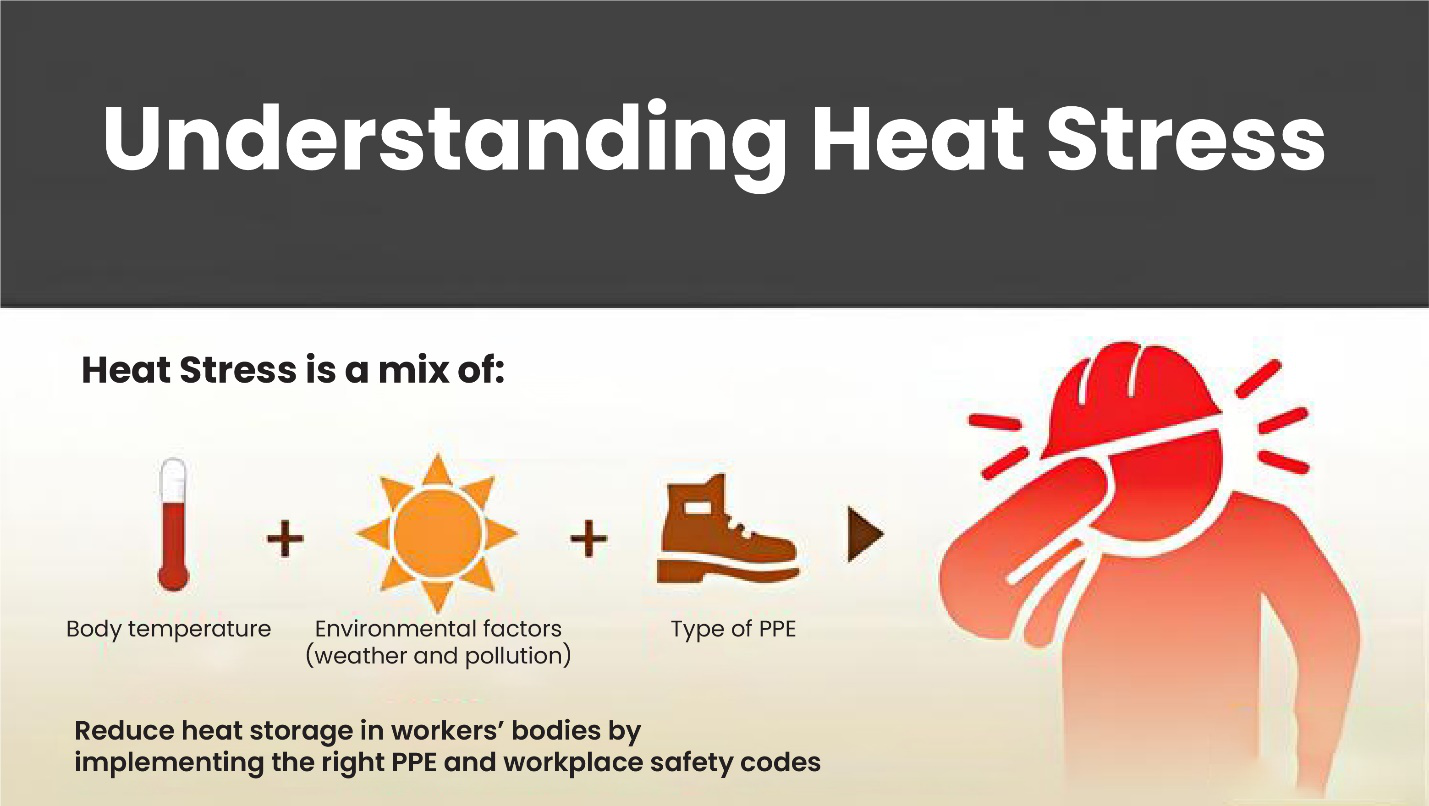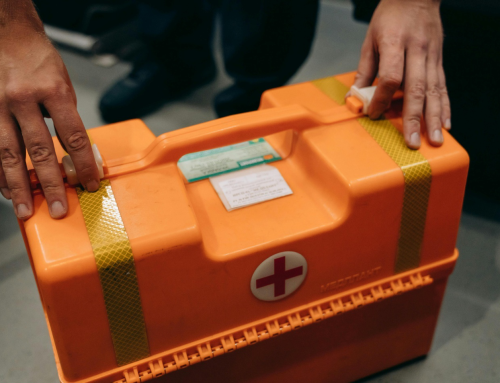As temperatures rise, so does the risk of heat-related illnesses in the workplace. From construction sites to firefighting operations, professionals exposed to high temperatures are susceptible to heat stress and exhaustion.
This comprehensive guide will delve into the dangers of heat-related illnesses, the signs and symptoms to watch for, and effective prevention strategies to stay safe in hot environments. Whether you’re working outdoors or indoors in poorly ventilated areas, understanding heat stress is essential for safeguarding your health and well-being.
Understanding Heat Stress and Exhaustion
Heat stress occurs when the body’s ability to regulate its internal temperature is overwhelmed by external heat. Prolonged exposure to high temperatures, combined with physical exertion and inadequate hydration, can lead to heat exhaustion or even heat stroke, a life-threatening condition. Individuals working in construction, agriculture, and firefighting industries are particularly vulnerable to heat-related illnesses due to their exposure to intense heat and physical exertion.
Reasons for Heat Stress and Exhaustion in the Workplace
Working in hot environments can lead to heat stress and exhaustion, posing serious risks to employee health and safety. Several factors contribute to the development of heat-related illnesses, including:
High Temperatures
Exposure to high ambient temperatures is a primary risk factor for heat stress and exhaustion. Industries such as construction, agriculture, and manufacturing often require workers to operate in environments where temperatures can soar, especially during summer months.
Humidity Levels
High humidity levels exacerbate heat stress by hindering the body’s ability to dissipate heat through sweat evaporation. In humid conditions, sweat cannot evaporate as effectively, leading to an increased risk of overheating and dehydration.
Physical Exertion
Physical exertion, such as heavy lifting, repetitive tasks, or prolonged standing, increases metabolic heat production, elevating core body temperature. Combined with high temperatures, strenuous work can quickly lead to heat-related illnesses.
Inadequate Hydration
Failure to maintain adequate hydration levels is a common cause of heat stress and exhaustion. Sweating depletes the body’s fluids and electrolytes, leading to dehydration if not replenished regularly. Proper hydration, as emphasized in Occupational First Aid Level 1 in Vancouver, is crucial for preventing heat-related illnesses.
Lack of Acclimatization
Workers who are not acclimatized to hot environments are at higher risk of heat-related illnesses. Acclimatization involves gradual exposure to heat, allowing the body to adapt and become more efficient at dissipating heat through sweating. Occupational First Aid Level 2 in BC training programs often cover this aspect.
Poor Ventilation
Inadequate ventilation in indoor work environments can impede airflow and heat dissipation, contributing to the buildup of heat stress. Proper ventilation measures, as recommended in OFA courses, are essential for maintaining a safe work environment.
Personal Protective Equipment (PPE)
Certain types of personal protective equipment (PPE), such as heavy clothing, respiratory masks, or protective suits, can restrict heat dissipation and increase heat stress. Workers in industries requiring PPE must balance the need for protection with the risk of heat-related illnesses.
Time of Day
Working during the hottest parts of the day, typically between 10 a.m. and 4 p.m., increases the risk of heat stress and exhaustion. Employers should schedule outdoor work tasks during cooler times of the day whenever possible to minimize heat-related risks. Incorporating heat stress considerations into fall protection courses in Surrey and confined space safety training is crucial for comprehensive workplace safety.
Signs and Symptoms of Heat Stress and Exhaustion
Recognizing the signs and symptoms of heat stress and exhaustion is crucial for early intervention and preventing serious complications. Understanding these indicators can help workers and supervisors take prompt action to mitigate risks and ensure the well-being of employees. Below are the common signs and symptoms of heat-related illnesses:
Excessive Sweating
Excessive sweating is the body’s natural response to regulate its temperature in hot environments. Workers experiencing profuse sweating may be at risk of dehydration and heat-related illnesses. Proper hydration practices, as emphasized in Occupational First Aid Level 1 in Vancouver, can help replenish lost fluids and prevent complications.
Fatigue
Heat stress can lead to fatigue and lethargy, making it challenging for workers to perform their tasks effectively. Fatigue may be accompanied by weakness and a general feeling of exhaustion. Occupational First Aid Level 2 in BC covers topics related to recognizing signs of fatigue and providing appropriate support to affected individuals.
Headache
Headaches are a common symptom of heat stress and exhaustion, often resulting from dehydration and increased blood flow to the brain. Workers experiencing persistent headaches in hot environments should take immediate measures to cool down and hydrate. Awareness of headache symptoms is crucial for early intervention, as discussed in Occupational First Aid Level 3 and Occupational First Aid Level 3Pro Renewal in BC.
Dizziness
Dizziness or lightheadedness can occur when the body struggles to maintain its balance and equilibrium in high temperatures. Workers experiencing dizziness should stop their activities immediately and seek shade or cooler environments. Proper training in fall protectionin Surrey emphasizes the importance of recognizing signs of dizziness and taking appropriate safety measures.
Nausea
Nausea or feeling queasy is another common symptom of heat-related illnesses, often accompanied by stomach discomfort or vomiting. Workers experiencing nausea should rest in a shaded area, sip water, and seek medical attention if symptoms persist. Occupational First Aid training equips individuals with the knowledge to recognize and respond to symptoms of nausea effectively.
Muscle Cramps
Muscle cramps, characterized by sudden and involuntary contractions of muscles, can occur due to dehydration and electrolyte imbalances in hot environments. Adequate hydration and electrolyte replenishment are essential for preventing and alleviating muscle cramps. Training in confined spacesafety for monitors and entrants emphasizes the importance of maintaining proper hydration levels to prevent muscle cramps and other heat-related symptoms.
Heat Stroke
If left untreated, heat exhaustion can progress to heat stroke, a life-threatening condition characterized by a high body temperature (above 103°F or 39.4°C), confusion, loss of consciousness, and seizures. Heat stroke requires immediate medical attention, and individuals should be cooled down rapidly while waiting for emergency responders to arrive.
Prevention Strategies for Heat-Related Illnesses
Implementing effective prevention strategies is essential for mitigating the risks of heat-related illnesses in the workplace. By incorporating the following detailed strategies, employers can create safer environments for workers exposed to high temperatures:
Hydration
Staying hydrated is paramount in preventing heat-related illnesses. Encourage workers to drink plenty of water throughout the day, even if they don’t feel thirsty. Water is the best choice for hydration, as it helps replenish lost fluids and regulate body temperature. Avoid caffeinated and alcoholic beverages, as they can contribute to dehydration.
Employers should provide easy access to water and encourage regular hydration breaks for workers. Training programs in Vancouver emphasize the importance of hydration and equip individuals with the knowledge to recognize and address dehydration effectively.
Proper Clothing
The choice of clothing plays a crucial role in managing heat stress. Workers should wear lightweight, loose-fitting clothing that allows sweat to evaporate and helps regulate body temperature. Light-colored clothing reflects sunlight, reducing heat absorption and minimizing the risk of overheating.
Additionally, consider wearing moisture-wicking fabrics that draw sweat away from the skin, keeping the body cool and dry. Educating workers on proper clothing choices is essential for preventing heat-related illnesses, as covered in Occupational First Aid Level 2 training programs.
Schedule Breaks
Implementing a work-rest schedule is vital for allowing employees to take frequent breaks and rest in shaded or air-conditioned areas. Limit outdoor work during the hottest parts of the day, typically between 10 a.m. and 4 p.m., when temperatures are at their peak.
Adjust workloads to minimize physical exertion during these hours, reducing the risk of heat-related illnesses. Training programs, including Occupational First Aid Level 3 and Occupational First Aid Level 3Pro Renewal in BC, emphasize the importance of scheduling breaks and managing workloads to prevent heat stress.
Shade and Ventilation
Providing adequate shade and ventilation in outdoor work areas is essential for reducing exposure to direct sunlight and facilitating airflow. Erect temporary shelters or canopies to create shaded areas where workers can rest and cool down.
Use fans, misting systems, or portable air conditioning units to circulate air and create a cooler work environment. Employers should conduct regular assessments to identify and address heat stress hazards in the workplace, ensuring that adequate measures are in place to protect workers. Training programs, such as Fall Protection courses in Surrey, often include guidelines on creating safe work environments in hot conditions.
Educating workers about the risks of heat-related illnesses and the importance of prevention is essential for fostering a culture of safety. Metro Safety Training stands as your beacon of safety in today’s ever-evolving workplace landscape. With our expert-led courses and hands-on learning approach, we empower your workforce to navigate hazards confidently and ensure a secure working environment.
Explore our diverse array of courses, including Occupational First Aid Levels 1, 2, and 3, Fall ProtectionTraining, and more in Surrey. Call now for more details.












